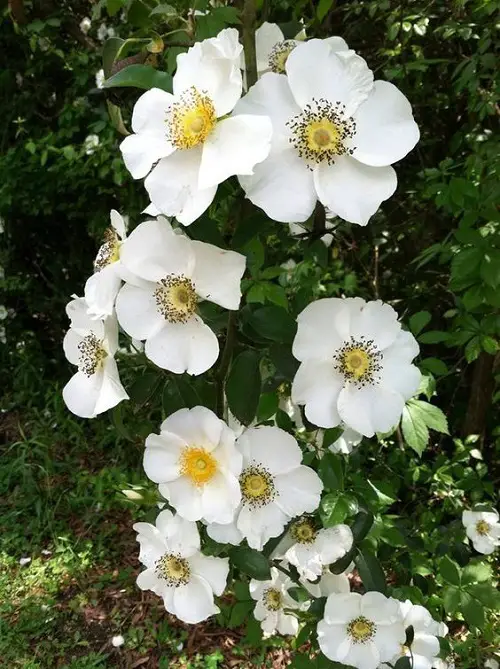White blooms signify purity, innocence, and a sense of tranquility; if you want them in your yard, learn How to Grow Cherokee Rose!

Nothing beats the elegance of white roses, and what can be more beautiful than the ones rambling around a pergola or garden obelisk? If you want such an addition, here’s everything on How to Grow Cherokee Rose!
Discover the Best Shade Tolerant Roses here
Cherokee Rose Plant Profile

The State Flower of Georgia, Cherokee Rose features gorgeous five-petalled white flowers with golden yellow stamens on glossy green foliage. Apart from its historical significance, the flower is noted for its vigorous growth habit that spreads to about 6-20 feet tall and looks beautiful around garden pergolas, arbors, and pillars.
Pear-shaped, bristly edible rosehips follow the pretty white blooms in the summer.
Botanical Name: Rosa laevigata
Learn more about the Georgia State Flower here
Cherokee Rose Propagation
The easiest way to propagate Cherokee Roses is through hardwood cuttings in fall. Snip a few 5-6 inches of cuttings from a healthy hardwood stem below the leaf node.
Remove the bottom leaves, leaving the top pair intact. Scratch the cut ends a little using a sanitized tool and plant them in a pot with a well-draining medium. Water well and place them in a well-lit location with bright indirect sunlight. You’ll notice new growth in 30-40 days.
Learn a Fantastic Rose Propagating Hack here
Ideal Pot Size for Growing Cherokee Rose
An 8-10 inches pot will be ideal for growing this beautiful rambling cultivar. However, you may need to re-pot it to one size bigger pot depending on the growth and spread of the plant, which can be once in 2-3 years.
Find out some Fantastic Rose Trellis Ideas here
Requirements for Growing Cherokee Rose

Sunlight
Cherokee roses prefer 5-6 hours of bright direct sunlight. While the plant tolerates partial shade, it will produce lesser flowers and show leggy growth if exposed for longer periods.
Grow the plant in the sunniest corner of your garden for the best blooms.
Soil
The rambling rose variety is not very fussy about the soil variety. However, it grows best in humus-rich, well-draining, moist soil with a pH of 5-6-7.8.
It won’t mind a clayey medium too. Take equal parts of clayey soil, sandy loam, and well-rotten manure for a perfect blend.
Water
Cherokee Roses thrive in a moist but well-draining medium. Water whenever the topsoil feels dry to the touch. If you find wilted or faded leaves, it may be a sign of insufficient watering.
The best bet is to follow a deep watering schedule once or twice a week, depending on the weather conditions.
Temperature & Humidity
It is a cool-weather cultivar and thrives in the temperature range of 59-79 F or 15-26C. Temperatures below 39F or 4C and above 86F or 30C will stunt its growth and produce shrunken pale flowers.
The plant loves a moist atmosphere. While growing outdoors, make sure to grow it near other plants to cover the moisture needs.
Cherokee Rose Care

Fertilizers
Fertilize the plant with a balanced 10-10-10 blend diluted to half its strength when new buds are set. You may also side-dress the roots with a granular feed during the spring when new growth emerges.
Find out the Best Rose Fertilizers from your Kitchen here
Pests and Diseases
The plant is prone to common rose issues like rose rust, leaf hopper, rose aphids, and black spots, among others. Spray the plant with an insecticidal soap solution or a strong jet of water to remove these pests.
Avoid overhead watering and grow the plant in good air circulation to keep potential diseases at bay.
Mulching
It is important to use a thick layer of mulch during summer and dry winters to retain soil moisture and suppress weed growth. Add a layer of fallen leaves, birch chips, or shredded wood for the best protection.


